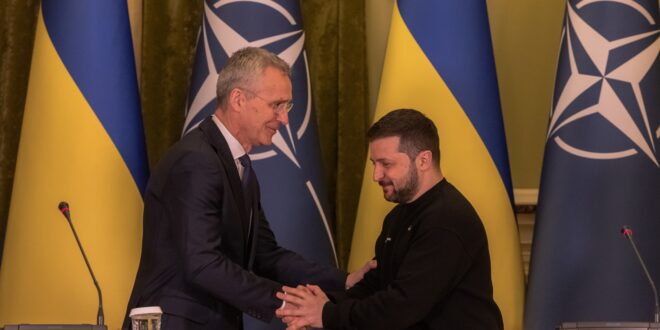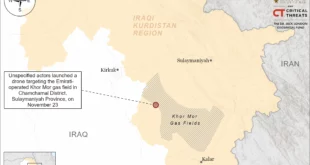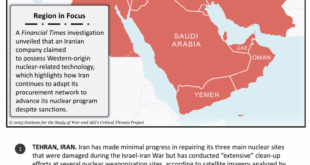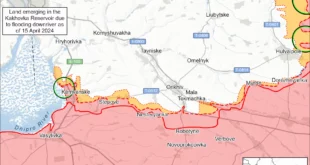The allies have to find a way to end the war without sacrificing Ukraine in the process.
At this week’s celebration of NATO’s seventy-fifth anniversary, there will be plenty of self-congratulatory speeches about the strongest, most enduring, and most successful alliance in history and promises to keep it that way well into the future. Such optimism looks increasingly detached from the reality facing the allies as they struggle to fulfill their most important missions since the Cold War—to support Ukraine and to help it defeat Russia.
Two and a half years into what has become a war of attrition, the outlook for Ukraine is grim. Last year’s optimistic forecasts about putting Russian forces in an untenable situation during the Ukrainian counteroffensive and forcing Putin to negotiate in earnest have not materialized. Despite intense fighting and massive losses by both sides, the line of contact remains today essentially where it was at the end of 2022. Ukraine’s armed forces have dug in and transitioned to a long-term defensive strategy. Such a strategy represents a fundamental change from President Volodymyr Zelensky’s long-standing goal of liberating all Russian-occupied territory. An open-ended stalemate is not a convincing theory of victory.
In contrast, Russian President Vladimir Putin’s theory of victory is clear. Since his initial blitzkrieg plan collapsed, the Russian leader has bet on winning at attrition warfare against Ukraine. The Russian army is making incremental gains on the battlefield, but the main Russian action is against Ukrainian cities and towns, infrastructure, and the spirit of the people of Ukraine. Relentless Russian bombardment has resulted in the destruction of well over half of Ukraine’s power generation capacity. Western allies and partners are scrambling to provide Ukraine with as much air defense capability as they can get their hands on, but Russia appears to have no trouble getting more bombs and missiles to sustain its campaign. And the damage to Ukrainian infrastructure is already done and is unlikely to be repaired in the foreseeable future. Putin’s bet is brutally transparent and simple—in a war of attrition, the side that has more of everything wins. And Russia has more of everything, including time. Putin is under no pressure to end this war.
Since Russia’s war began—whether two and a half years ago or ten years ago when Russia launched its first assault on Ukraine and occupied Crimea—the North Atlantic alliance has not lived up to its pledge to, in the words of French President Emmanuel Macron, “do everything necessary to make sure Russia does not win this war.” The allies are shifting their focus to the long term. The United States, the UK, France, Germany, and other allies have signed long-term agreements to provide Ukraine with military support and training. NATO is setting up a new command, dedicated to supporting Ukraine, which will be staffed by some 700 personnel from various countries. This burst of activity is due to the allies’ desire to “Trump-proof” support for Ukraine in case the former U.S. president is elected again and acts on his promise to end the war in twenty-four hours by cutting off aid to Ukraine and forcing it to capitulate. But these long-term commitments are less than they appear to be. When NATO Secretary-General Jens Stoltenberg proposed setting up a €100 billion ($108 billion) multiyear fund to support Ukraine’s war effort, the allies balked at it. Ultimately—almost at the last minute, in time to have a deliverable for the summit—they made a conditional promise of €40 billion ($43 billion) for one year, rather than several years.
The bilateral security agreements that the United States, France, Germany, and other allies have signed with Ukraine are promises to provide it with weapons and training but not, contrary to what the term implies, promises to come to Ukraine’s rescue. The “bridge to membership” label the allies have attached to these promises is anything but that. NATO membership is not on the table for Ukraine at this anniversary summit and probably not in the foreseeable future. As long as Ukraine is at war with Russia, the allies are not willing to grant it membership, since that would mean going to war with Russia. U.S. President Joe Biden said last month in his TIME Magazine interview that he was “not prepared to support the NATOization of Ukraine.” No better friend of Ukraine than Biden will occupy the White House in the foreseeable future, and should there be another Donald Trump presidency, Ukraine will have virtually no chance of joining the alliance.
Moreover, promises of long-term support don’t deal with and, arguably, even avoid answering the question of what the goal of that support is. Few if any military analysts will argue that Kyiv’s official goal of liberating all Russian-occupied territory is feasible. The goal now appears to be to prevent Ukraine from losing the war and to convince Putin that he will never force Ukraine into submission.
That is having little effect on Putin. The barbaric massacre at the children’s hospital in Kyiv indicates that he will stop at nothing. His commitment to prosecute the war and, if necessary, destroy Ukraine is open-ended.
The allies’ commitment to support Ukraine is not open-ended. The “it” in the allies’ “as long as it takes” pledge has never been defined. Political shifts on both sides of the Atlantic could bring about big changes in the allies’ commitments to Ukraine.
It is magical thinking to expect that the current level of allied support can continue indefinitely. In the United States, the outlook for future congressional backing for more support packages for Ukraine on the scale of the $61 billion supplemental funding for Ukraine passed in April is bleak. It is equally improbable that Ukraine can either hold out indefinitely or turn the tide of the war with the current level of allied support.
NATO has rejected direct involvement in the war. Instead, it has engaged in creeping escalation by delivering more and more lethal weapons to Ukraine. The lack of a Russian response has led some officials to conclude that Russian warnings about retaliation or red lines are merely psychological warfare and warrant little caution on the part of the allies, who should enable bold action by Ukrainians to inflict more pain on Russia.
The war in Ukraine has no precedent in the Cold War era. NATO is facing a more precarious situation than anything it had to deal with then. The Soviet Union and the United States waged proxy wars then in distant theaters—in Vietnam, Angola, and the Congo. Those wars did not pose a threat to either superpower’s heartland. Nor would either superpower tolerate such threats. In 1962, the United States went to the brink of nuclear war with the Soviet Union when Soviet missile sites were discovered in Cuba, 90 miles from Key West. The Soviets wanted to deploy their missiles to Cuba to counter U.S. missiles deployed in Türkiye near the Soviet border. Sixty years later, NATO is financing and arming Ukraine’s fight against Russian aggression, and Ukraine is launching strikes into the Russian heartland every day. The point is not whether Ukraine has the right to defend itself and retaliate against Russian brutality. It has. Putin’s criminal blunder is why Ukrainian drones are striking Russian refineries. The point is that these are vastly different stakes than what the allies dealt with during the Cold War.
Having ruled out direct involvement, NATO allies find themselves at an impasse. On the one hand, they all recognize the unsustainable option of doing more of the same and expecting a different result. Staying the course also carries with it the risk of unintended escalation and little prospect of victory for Ukraine. On the other hand, they have zero appetite to negotiate with Putin, an accused war criminal leader wanted by the International Criminal Court. This unpalatable option is also unrealistic, since Putin has shown no inclination to negotiate until after a Ukrainian surrender.
The challenge before the allies at this summit is bigger than anything they have faced since the Cold War. It is not to keep Ukraine in the fight for the long run but to find a way to end this war without sacrificing Ukraine in the process.
 Eurasia Press & News
Eurasia Press & News



